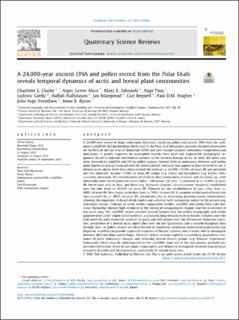| dc.description.abstract | A 24,000-year record of plant community dynamics, based on pollen and ancient DNA from the sediments (sedaDNA) of Lake Bolshoye Shchuchye in the Polar Ural Mountains, provides detailed information on the flora of the Last Glacial Maximum (LGM) and also changes in plant community composition and dominance. It greatly improves on incomplete records from short and fragmented stratigraphic sequences found in exposed sedimentary sections in the western Russian Arctic. In total, 162 plant taxa were detected by sedaDNA and 115 by pollen analysis. Several shifts in dominance between and within plant functional groups occurred over the studied period, but most taxa appear to have survived in situ. A diverse arctic-alpine herb flora characterised the interval ca. 24,000–17,000 cal years BP and persisted into the Holocene. Around 17,000 cal years BP, sedges (e.g. Carex) and bryophytes (e.g. Bryum, Aulacomnium) increased. The establishment of shrub-tundra communities of Dryas and Vaccinium sp., with potentially some Betula pubescens trees (influx ∼290 grains cm2 year−1), followed at ca. 15,000 cal years BP. Forest taxa such as Picea and ferns (e.g. Dryopteris fragrans, Gymnocarpium dryopteris) established near the lake from ca. 10,000 cal years BP, followed by the establishment of Larix trees from ca. 9000 cal years BP. Picea began to decline from ca. 7000 cal years BP. A complete withdrawal of forest tree taxa occurred by ca. 4000 cal years BP, presumably due to decreasing growing-season temperatures, allowing the expansion of dwarf-shrub tundra and a diverse herb community similar to the present-day vegetation mosaic. Contrary to some earlier comparative studies, sedaDNA and pollen from Lake Bolshoye Shchuchye showed high similarity in the timing of compositional changes and the occurrence of key plant taxa. The sedaDNA record revealed several features that the pollen stratigraphy and earlier palaeorecords in the region failed to detect; a sustained, long-term increase in floristic richness since the LGM until the early Holocene, turnover in grass and forb genera over the Pleistocene-Holocene transition, persistence of a diverse arctic-alpine flora over the late Quaternary, and a variable bryophyte flora through time. As pollen records are often limited by taxonomic resolution, differential productivity and dispersal, sedaDNA can provide improved estimates of floristic richness and is better able to distinguish between different plant assemblages. However, pollen remains superior at providing quantitative estimates of plant abundance changes and detecting several diverse groups (e.g. Poaceae, Cyperaceae, Asteraceae) which may be underreported in the sedaDNA. Joint use of the two proxies provided unprecedented floristic detail of past plant communities and helped to distinguish between long-distance transport of pollen and local presence, particularly for woody plant taxa. | en_US |

